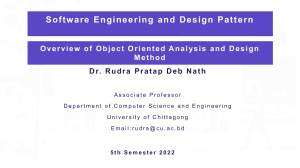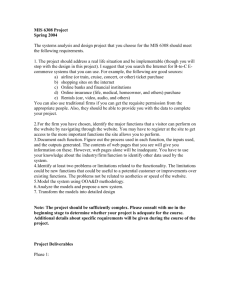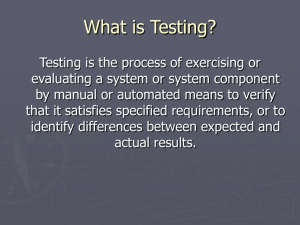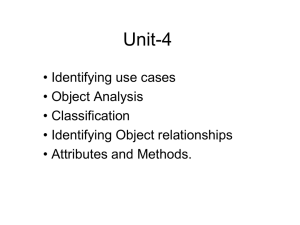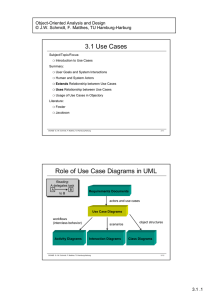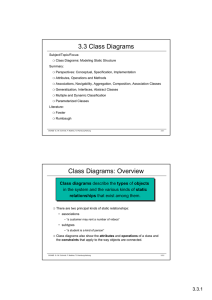Identifying usecases..
advertisement
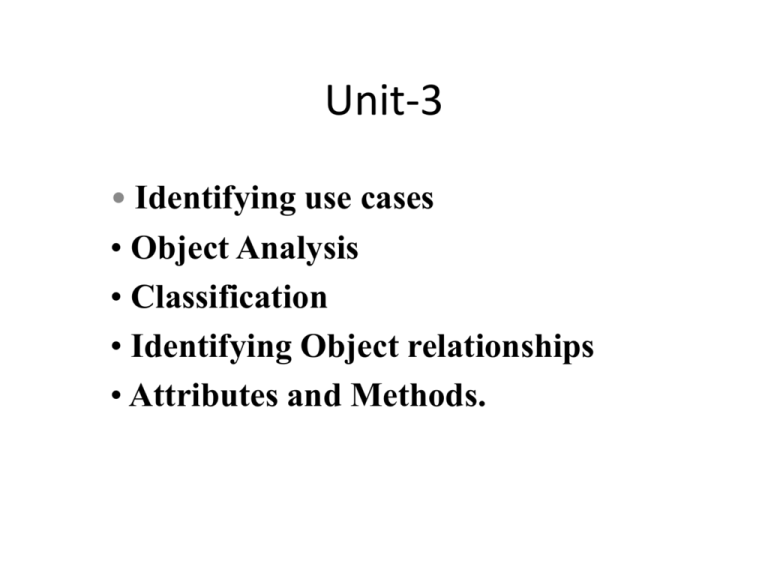
Unit-3 • Identifying use cases • Object Analysis • Classification • Identifying Object relationships • Attributes and Methods. • Identifying Use Cases • Object Analysis: Classification • Identifying object relationships, Attributes and Methods. 1.Object oriented analysis Process: Identifying Use cases Identifying the use cases: Goals • The use-case approach to object-oriented analysis and the object-oriented analysis process. • Identifying use cases. • Identifying actors. • Documentation. The analyst has major tools for extracting information about a system 1. Examination of existing system documentation. 2. Interviews. 3. Questionnaire. 4. Observation. 5.Literature Review Requirements Difficulties Three most common sources of requirements difficulties are: 1. Incomplete requirements. 2. Fuzzy descriptions (such as fast response). 3. Unneeded features.(unnecessary) Use case driven Object-Oriented Analysis (OOA) :The unified approach The OOA phase of UA uses actors and use cases to describe the system. The actors are external factors that interact with the system. Use cases are scenarios that describe how actors use the system. The OOA Process in UA Develop UseCases, ADs Identify Actors prototyping Develop Interaction Diagrams Identify Classes, Relationships, Attributes & Methods O-O Analysis Refine and iterate The Object-Oriented Analysis (OOA) Process • The process consists of the following steps: • 1. Identify the actors: – Who is using the system? – Or, in the case of a new system, who will be using system? The OOA Process (Con’t) • 2. Develop a simple business process model using UML activity diagram. The OOA Process (Con’t) • 3. Develop the use case: – What the users are doing with the system? – Or, in the case of a new system, what users will be doing with the system? Use cases provide us with comprehensive documentation of the system under study. The OOA Process (Con’t) • 4. Prepare interaction diagrams: – Determine the sequence. – Develop collaboration diagrams. The OOA Process (Con’t) • 5. Classification—develop a static UML class diagram: – Identify classes. – Identify relationships. – Identify attributes. – Identify methods. The OOA Process (Con’t) • 6. Iterate and refine: If needed, repeat the preceding steps. Developing Business Processes • Developing an activity diagram of the business processes can provide us with an overall view of the system. Use Case Model • Use cases are scenarios for understanding system requirements. • The use-case model describes the uses of the system and shows the courses of events that can be performed. • Some Definitions – – – – User – Human Users + Other Systems Use Case – A piece of functionality Use-Case Model – All the use cases Use-Case Driven – Development process follows a flow Use Case Model (Con’t) • Use case defines what happens in the system when a use case is performed. • The use-case model captures the goals of users and system's responsibilities to it’s user. • Use case model provides an external view of s/m or application. Use Cases Under the Microscopedefinition by Jacobson • "A Use Case is a sequence of transactions in a system whose task is to yield results of measurable value to an individual actor of the system." What is a Use Case again? Use Associations • The use association occurs when you are describing your use cases and notice that some of them have common subflows. • The use association allows you to extract the common subflow and make it a use case of its own. Extends Associations • The extends association is used when you have one use case that is similar to another use case but does a bit more or • Is more specialized; in essence, it is like a subclass. Library uses Borrow books extends Checking Library Card uses Inter library loan Circulation Clerk Member Return Books Performing research Reading books Newspaper Supplier Purchasing Supplies Here , all use cases are concrete use cases.Because all use cases interact with the actors. Types of Use Cases • Use cases could be viewed as concrete or abstract. • An abstract use case is not complete and has no initiation actors but is used by a concrete use case, which does interact with actors. • Abstract use case may have uses or extends associations. Guidelines for use case modeling 1.Capture the simple and normal use case first 2.For every step in that use case , ask what could go wrong here? How might this work out differently? 3.Extract common sequences with uses association.Use extends association when more specialized use case is used.
